A Case Based Reasoning System For Recommendation Of Restaurant In Jimbaran Using K-Nearest Neighbor
on
p-ISSN: 2301-5373
e-ISSN: 2654-5101
Jurnal Elektronik Ilmu Komputer Udayana
Volume 9, No 2. November 2020
A Case Based Reasoning System For Recommendation Of Restaurant In Jimbaran Using K-Nearest Neighbor
I Gede Teguh Mahardikaa1, I Wayan Suprianaa2
aInformatics Department, Udayana University Badung, Bali, Indonesia 1teguhmahardikaa@gmail.com 2wayan.supriana@unud.ac.id
Abstract
Culinary is one of the favorite businesses today. The number of considerations to choose a restaurant or place to visit becomes one of the factors that is difficult to determine the restaurant or place to eat. To get the desired place to eat advice, one needs a recommendation system. Decisions made by the recommendation system can be used as a reference to determine the choice of restaurants. One method that can be used to build a recommendation system is Case Based Reasoning. The Case Based Reasoning (CBR) method mimics human ability to solve a problem or cases. The study used the K-Nearest Neighbor method to find closeness between new cases and case bases. With the selection of features used as domains in the system, the results of recommendations presented can be more suggestive and accurate. The system successfully provides complex recommendations based on the type and type of food entered by the user. Based on blackbox testing, the system has features that can be used and function properly according to the purpose of creating the system.
Keywords: Recommendation System, Case Based Reasoning, K-Nearest Neighbor, Black Box, CBR.
Business development in Indonesia is quite rapid. Culinary is one of the favorite businesses today. Ranging from teenagers to adults love to explore culinary places. The number of considerations to choose a place to visit is one of the factors in determining where to eat. To get the desired place to eat advice, a recommendation system is needed.
Recommendation systems are software that assists a person in providing advice; advice provided will be utilized by the user in making decisions [1]. Recommendation system is a system that is used to assist users in selecting or purchasing an item [8]. Decisions made by the recommendation system can be used as a reference to determine the choice of restaurants. The recommendation stipulated is the name and address of the restaurant that has been obtained. The only restaurant that is the solution in Jimbaran area of Bali. There are 44 record data and 30 restaurant data that has different menus, views and prices. Restaurant data is obtained from the results of the survey to the restaurant itself, while the record data is obtained by giving questionnaires periodically to different people. The recommendation system requires a method to provide optimal solutions. One method that can be used to build a recommendation system is Case Based Reasoning.
Case Based Reasoning (CBR) is a method used to solve a problem based on solutions from previous cases. The Case Based Reasoning (CBR) method mimics human ability to solve a problem or cases [2]. The Case Based Reasoning (CBR) method has 4 stages namely retrieval, reuse, revise and retain. The retrieval process is the most important stage, because at this stage the search for a solution for a new case is carried out. The similarity value or proximity value between the new case and the old case will be the final solution for the user. One method to test the proximity value between new cases and the case base is K-Nearest Neighbor.
K-Nearest Neighbor in this study will look for the value of proximity between a new case and a case base that will later be a reference in determining the restaurant. The K-Nearest Neighbor process can be said to be simple and has several advantages such as ease, effectiveness and
competitive classification performance in many domains [3]. In calculating the likeness or similarity value of a case, it must be ensured that the system has a case base or knowledge base that will be used to measure the level of similarity or similarity. The problem will be solved by calling back an old case or knowledge base so that it becomes a solution to the problem facing the user.
Based on the description of the problem, the research that will be done is "A Case Based Reasoning System For Recommendation Of Restaurant In Jimbaran Using K-Nearest Neighbor". This research will provide recommendations for places to eat in Jimbaran based on a previously acquired case base. The new case will be compared to the case base to look for the value of proximity between data with the K-Nearest Neighbor method which will later be used as a place-to-eat recommendation.
In this study the data used was restaurant data obtained by deploying questionnaires. The number of restaurants obtained as many as 30 restaurants.
Data indexing is used to facilitate the process of finding similarities from existing cases on the case base. In the case base and retrive process as a stage of the Case base reasoning method, an indexing is required [7]. In this study indexing data was used to convert numbers that had large domains into the same domain or sub-domain. Here is the indexing data used:
Table 1. Indexing Case Base
|
Atribut |
Deskripsi |
Index |
|
Usia |
10-18 Tahun |
1 |
|
19-25 Tahun |
2 | |
|
26-40 Tahun |
3 | |
|
Tipe |
Nasi |
1 |
|
Mie |
2 | |
|
Roti |
3 | |
|
Bakso |
4 | |
|
Jenis |
Goreng |
1 |
|
Bakar |
2 | |
|
Rebus |
3 | |
|
Kuah |
4 | |
|
Isian |
Ayam |
1 |
|
Babi |
2 | |
|
Sapi |
3 | |
|
Ikan |
4 | |
|
Seafood |
5 | |
|
Campur |
6 | |
|
Level |
Pedas |
1 |
|
Standar |
2 | |
|
Topping |
Ya |
1 |
|
Tidak |
2 | |
|
View |
Pantai |
1 |
|
Dalam Ruangan |
2 | |
|
Luar Ruangan |
3 | |
|
Fungsionalitas |
Makan Biasa |
1 |
|
Rapat |
2 | |
|
Ulang Tahun |
3 | |
|
Makan Bersama Keluarga |
4 | |
|
Kencan |
5 | |
|
Nongkrong |
6 | |
|
Harga |
Murah |
1 |
|
Menengah |
2 | |
|
Mahal |
3 |
Mapping a problem is the first step in representing the case to be identified, stored and processed based on the given rule. The following table is an example of a case base representation of dining recommendations:
Table 2. Representation of Cases
|
Kode Kasus |
Usia |
Tipe |
Jeni s |
Isian |
Level |
Top ping |
Vie w |
Fun gsi |
Harga |
Resto ran |
|
1 |
1 |
1 |
1 |
1 |
1 |
2 |
2 |
3 |
2 |
12 |
|
2 |
1 |
2 |
4 |
1 |
2 |
2 |
2 |
1 |
1 |
3 |
|
3 |
3 |
3 |
2 |
3 |
1 |
2 |
2 |
5 |
3 |
18 |
|
4 |
2 |
3 |
1 |
1 |
2 |
2 |
2 |
6 |
2 |
1 |
|
5 |
2 |
1 |
1 |
1 |
2 |
2 |
2 |
3 |
2 |
2 |
|
. |
. |
. |
. |
. |
. |
. |
. |
. |
. |
. |
|
. |
. |
. |
. |
. |
. |
. |
. |
. |
. |
. |
In this study, the test scenario is described in the Case Based Reasoning design model. Case
Based Reasoning's design model consists of four important parts such as figure 1. namely [4]:
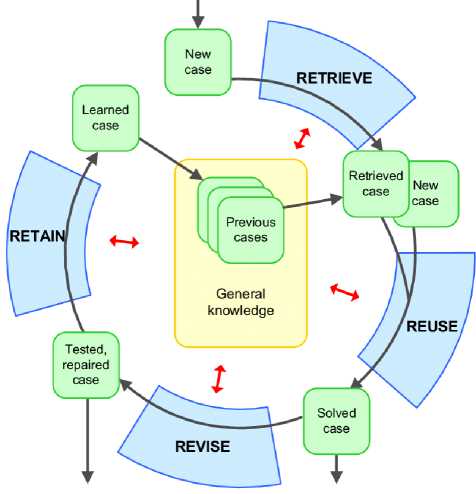
Figure 1. Case Based Reasoning Design Model [5]
Here is an explanation from Figure 1. [4]:
-
1. Retrieve
Regaining the case is most similar to matching a new case with an existing case base. The retrieving process uses the K-Nearest Neighbor method to get the proximity value between the new case and the existing case base.
-
2. Reuse
Use the knowledge and information of the draw conclusions to solve the problem.
-
3. Revise
Propose new solutions and knowledge of recently resolved problems to be stored on a case basis.
-
4. Retain
Save the newly solved problem and the solution to then be used to solve the problem in the next problem.
Feature selection is done to find features that have a correlation with class (restaurant) features. Feature selection can be tested by analyzing the significance of each feature against the class feature. A value of significance close to 1 has little effect on class features compared to a value of near 0 significance. Then features that have a significance value below 0.05 will be used as sub-domains in this study. Feature selection will be analyzed with Pearson's Bivariate Correlation on IBM SPSS Statistics software. The following are the results of Pearson's Bivariate Correlation analysis on the basis of the case that has been obtained:
Table 3. Pearson Bivariate Correlation Analysis Results
|
Restoran |
Pearson Correlati on |
.103 |
.410* * |
.356* |
.179 |
-.195 |
-.142 |
-.018 |
-.213 |
.228 |
1 |
|
Sig. (2tailed) |
.506 |
.006 |
.018 |
.245 |
.204 |
.357 |
.906 |
.165 |
.136 | ||
|
N |
44 |
44 |
44 |
44 |
44 |
44 |
44 |
44 |
44 |
44 |
Based on the table above, the features of food type and type will be sub-domaind in this study as it has a significance value below 0.05. The restaurant recommendations provided will follow the features of the type and type of food that customers input.
3.2 Database Relationships
The database relationships used in this study can be seen in figure 2:
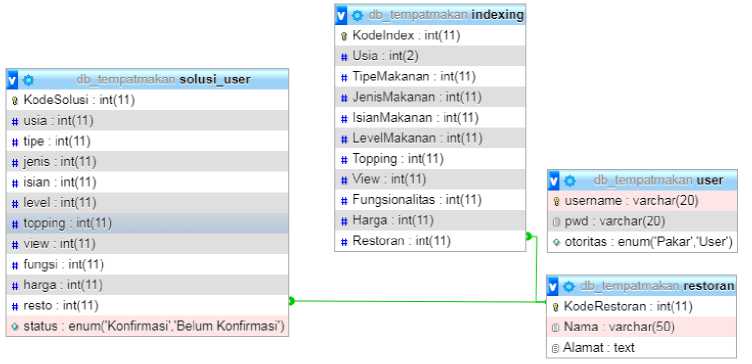
Figure 2. Database Relationships
3.3 Web Page View
3.3.1 Admin Login Page
The Admin Login page is used by admins or experts to log into the system. When logging in, there are dashboard pages, new cases and restaurants. So only admins or experts can access all three pages. Here's what the admin sign-in page looks like:
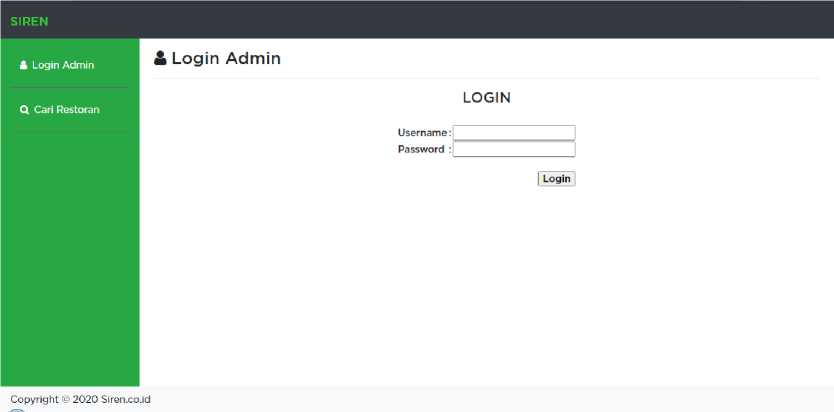
Figure 3. Login Page
The restaurant search page is a page that everyone can access without logging in. This page will ask users to enter criteria that already have rules. From these criteria will be given recommendations or suggestions of places to eat. Here's what the restaurant looks like:
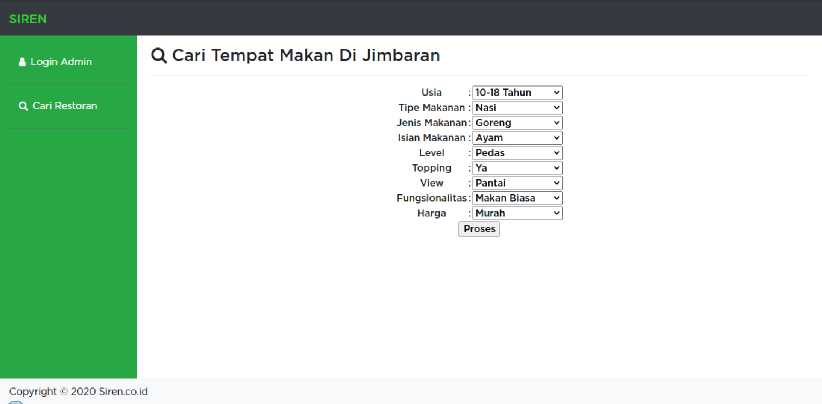
Figure 4. Restaurant Search Page for Users
The restaurant recommendation page is a page that contains recommendations or suggestions for places to eat according to the user's enter. In the restaurant recommendation page, it will display the number of restaurants as many as k or neighbor on the knn where in this system k is worth 5. Here's a look at the restaurant recommendation page:
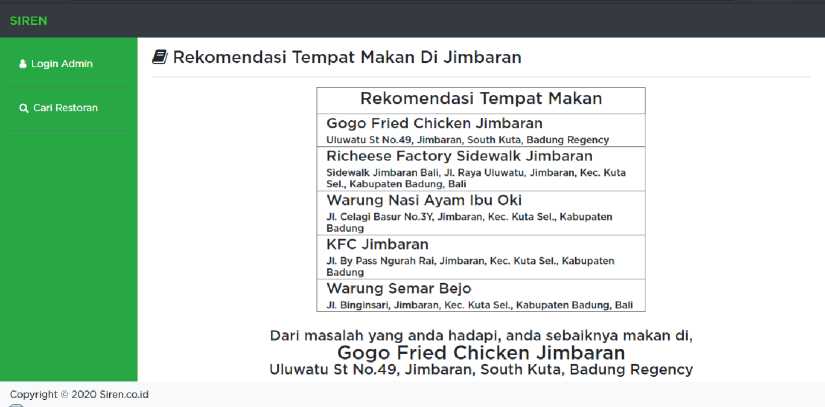
Figure 5. Restaurant Recommendation Page for Users
Dashboards are used to view the number of existing knowledge bases and the number of restaurants available in the system. Dashboard pages can only be viewed by admins or experts. Here's a dashboard page view:
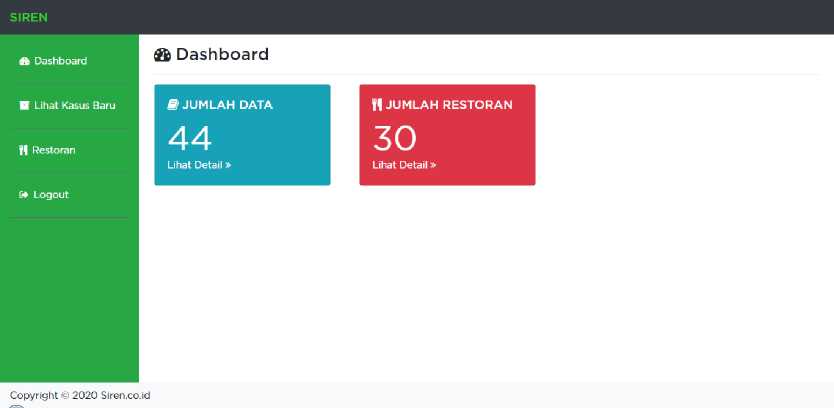
Figure 6. Dashboard
Kasus Baru pages are used by admins or experts to see feedback from users and restaurant solutions. The new case can then be entered into a database and used as a knowledge base to update the case base. A new case entered by the user is a case that does not yet exist on the case basis. So, admins or experts just need to sort out whether the data is valid or not. If valid, the admin or expert will press the data input button and the data will go into the case base to become a new knowledge base. Here's what the new case page looks like:

Figure 7. New Case Pages for Admin
The restaurant page is used to view previously acquired restaurants. One of the restaurants will be the solution of the new case entered by the user. Here's the restaurant page:
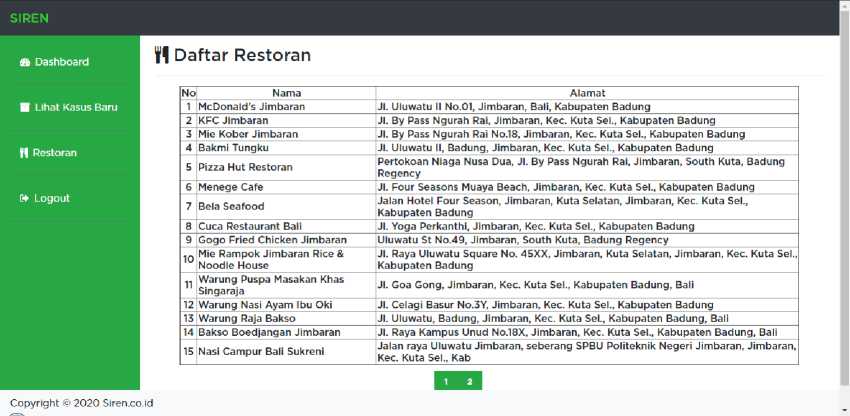
Figure 8. Restaurant Page
System testing is performed using the blackbox method. Testing with the blackbox method will ensure that all functions on the system can be used and function properly [6]. Here are the results of testing the system with the blackbox method:
Table 4. Admin Page Testing
|
No |
Expected |
Test Scenario |
Needs |
Test Results |
|
1 |
Admin Login |
If True |
Appears to Dashboard Page. |
Appropriate |
|
If Incorrect |
Warning Appears Wrong Username or Password. |
Appropriate | ||
|
2 |
New Case |
If True |
New Case Data is successfully entered into the data base. |
Appropriate |
|
If Incorrect |
New Case Data is not successfully entered into the data base. |
Appropriate | ||
|
3 |
The Restaurant |
If True |
Restaurant Data is displayed successfully. |
Appropriate |
|
If Incorrect |
Restaurant Data is not displayed successfully. |
Appropriate |
Table 5. User Page Testing
|
No |
Expected |
Test Scenario |
Needs |
Test Results |
|
1 |
Find Restaurants |
If New Cases |
Display Restaurant Recommendations on the Restaurant Recommendations page and New Case Data is stored in the New Case database. |
Appropriate |
|
If it's not a new case |
You'll just see restaurant recommendations on the Restaurant Recommendations page. |
Appropriate |
Based on table 4 and table 5, all menu test results and system features are appropriate and work properly.
The Recommended Place to Eat system in Jimbaran has been successfully built using case based reasoning method and K-Nearest Neighbor method. K-Nearest Neighbor is very influential in providing recommendations given by calculating the proximity between a new case and a case base. The system successfully provides complex recommendations based on the type and type of food entered by the user. With the selection of features used as domains in the system, the results of recommendations presented can be more suggestive and accurate. The results of testing the system with the blackbox method also support that the built-in system has the appropriate features and can function properly.
Reference
-
[1] R. A. Yunmar, "Sistem Rekomendasi Pemilihan Hotel dengan Case Based Reasoning," ELECTRICIAN – Jurnal Rekayasa dan Teknologi Elektro, pp. 53-60, 2017.
-
[2] R. Widiyana, "IMPLEMENTASI METODE CASE-BASED REASONING UNTUK REKOMENDASI TEMPAT OLEH-OLEH DI KOTA MALANG BERBASIS ANDROID," JATI (Jurnal Mahasiswa Teknik Informatika), pp. 763-769, 2017.
-
[3] C. S. D. Prasetya, "SISTEM REKOMENDASI PADA E-COMMERCE MENGGUNAKAN K-NEAREST NEIGHBOR," Jurnal Teknologi Informasi dan Ilmu Komputer (JTIIK), pp. 194-200, 2017.
-
[4] S. K. Pal and S. C. K. Shiu, Foundation of Soft Case-Based Reasoning, Wiley-Interscience, 2004.
-
[5] E. Y. P. M. H. P. S. Muhammad Syafril Hidayat, "PENERAPAN CASE BASED REASONING PADA SISTEM REKOMENDASI TOPIK SKRIPSI PROGRAM STUDI INFORMATIKA UPN
“VETERAN” JAWA TIMUR," Jurnal Informatika dan Sistem Informasi, vol. 1, no. 2, pp. 272281, 2020.
-
[6] A. M. Abdul Mubarak, "CASE-BASED REASONING UNTUK APLIKASI PEMILIHAN PESTISIDA HAMA PADI BERBASIS WEB," Jurnal Informatika dan Komputer, vol. 3, no. 2, pp. 119-124, 2020.
-
[7] K. D. P. I Wayan Supriana, "METODE PENALARAN BERBASIS KASUS (CASE BASE REASONING) DALAM PENENTUAN KELAYAKAN SEKOLAH PERAWATAN," Resistor, vol. 3, no. 1, pp. 57-65, 2020.
-
[8] I. G. A. G. A. Kadyanan, "PengembanganSistem Rekomendasi Tempat Pembuatan Kerajinan Tradisional Bali," Jurnal Ilmu Komputer, vol. 12, no. 1, pp. 39-47, 2019.
This page is intentionally left blank
276
Discussion and feedback